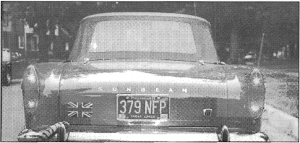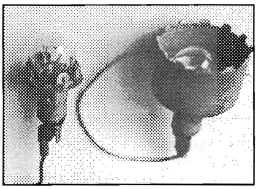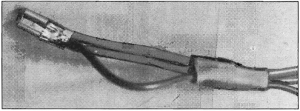by John Logan in the December 2001 RootesReview:
Sunbeams, like other small cars, suffer from having small closely spaced taillights that could lead drivers closing in behind you to think they have more time to react than they have.
How can this be improved?
Add tail lights! It is difficult to increase the spacing of the lights beyond the fenders but it is very easy to double the brightness of the taillights and increase their apparent vertical length.
All 60’s vintage Sunbeam taillight housings have two bulb sockets spaced on vertical axis. The top sockets hold single high wattage filament bulbs that are used for the turn signal lights. The bottom sockets hold double filament bulbs such as an 1157. These bulbs have low wattage filaments that are used for the rear running lights and high wattage filaments used for the brake lights. 
By replacing the upper single sockets with double filament sockets and wiring the extra low wattage filaments to the lower running lights, we will now have a total of four bulbs when the running lights are on.
Steps required to make the change.
First you have to find two lower, double filament sockets. I got mine from Russ Eshelman, but there are almost always housings with sockets at swap meets. In the early housings the sockets simply snap out. In the later housings you have to bend the retaining tabs on the sockets to get them out.
There are two types of sockets found in Sunbeam taillight housings. The in the illustration is from the housing of the Series 4 Alpine and Mk 1 Tiger (Lucas Assy. L654) with the lens screws on the inside. The one on the right is from a later housing of the Series 5 Alpine and Mk lA and Mk 2 Tiger that have the lens screws on the outside. Ed Esslinger tells me that the series 1, 2, and 3 Alpines also have sockets that are easily removable from the inside. 
Take the taillight housings out of the car. Remove the upper single filament sockets from the housings and replace them with the double filament sockets.
Next; make up two eight-inch jumper wires with female spade connectors on one end and 5/16 of an inch of the insulation stripped off the other ends.
Solder the wires to the female spade connectors on the red wires going to the lower double filament sockets. You can do this by pulling the soft plastic protector boots of the connectors back. Then run the jumper wires through the holes in the back of the boots. Solder the wires to the hollowed out portion of the connectors and push the boots back on the female connectors.
Reconnect the wires to the sockets with the new wires connected to the new low wattage spade connectors of the new upper sockets. 
Potential problems
The heat of the extra bulbs may cause the plastic lenses to deform. So far I haven’t had that problem and the lenses don’t feel very hot. If a problem arises I will drill small vent holes in the top and bottom of the housings.
It is against the law to have amber rear running lights, so those of you who want to retain the European amber turn signal lens should not make this modification.
You now have reduced the possibility of being rear ended at night!
